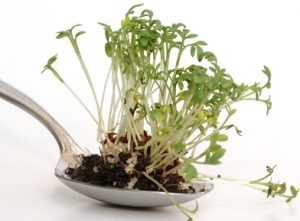This is a frustrating time for vegetable gardeners because the season is so short. Conveniently, November is the start of sprouting season for gardens that are relegated to the indoors. Many edible plants can be sprouted indoors and used as health boosters during the cooler months ahead. Micro greens harvested indoors from broccoli, kale, and pea sprouts are fun, but as they are not foolproof, why not begin with a couple of seeds designed for fail-proof sprouting?
 I suggest starting with wheat grass, Triticum aestivum. This is a particularly good choice for those who want to grow a lawn-like plant to remind them of summer, but it also makes a delicious addition to your favorite salad, sandwich, or entree. Served at juice bars for its health benefits, it usually is dumped into smoothies in the form of a tasteless powder. That’s why the better juice bars grow their own wheat grass, and so can you.
I suggest starting with wheat grass, Triticum aestivum. This is a particularly good choice for those who want to grow a lawn-like plant to remind them of summer, but it also makes a delicious addition to your favorite salad, sandwich, or entree. Served at juice bars for its health benefits, it usually is dumped into smoothies in the form of a tasteless powder. That’s why the better juice bars grow their own wheat grass, and so can you.
Seeds for wheat grass are available at health food stores and health food sections of conventional grocery stores. They can be very tricky to find, but they are there. Keep an eye out for “wheat berries” or “spring wheat,” which are other common names for wheatgrass. Finding them probably is more difficult than growing them. Because organic seeds are even more challenging to find, we hand picked a selection of prepackaged organic seeds to offer at the garden center. They’re stocked along with an easy to sprout seedbox.
If you look upon your seedlings as a merely functional addition to your pantry, any container will do. For the gardener who wants to keep grass growing through winter as an ornamental touch, a bonsai pot or more attractive container is recommended. As you continue harvesting the grass it takes on a dream-like state of an indoor lawn, which adds to its eye appeal. Whatever container you choose, it should have some drainage and hold at least an inch of potting soil, preferably two inches or more.
You can plant directly onto the soil and, as wheatgrass needs light to germinate, there is no need to cover the seeds. Simply soak the seeds in a glass jar or cup for 12 hours prior to planting. Just make sure there is enough water in the jar to cover the seeds while soaking. You will need about two tablespoons of dry seed to fill the average six-inch grower’s pot.
Thoroughly wet the soil once it is in the container. Then spread the damp seeds on top. Better success is to be had by covering the container with a clear lid for faster germination. Place your container under lights or at a window with good natural light. When the seeds begin to germinate, in about 24 hours, remove the clear lid.
The second easiest sprouts to grow are sunflower greens, Helianthus annuus. Of all the sprouts you can grow, none taste better than sunflower sprouts. You can find the seeds at the same locations you find wheat grass. I do not advise using the seed marketed as bird feed, as these are usually a lower grade and old seed.
The big difference between growing sunflower sprouts and wheat grasses is their light requirements. Sunflowers require darkness while germinating. The seeds require the same 12-hour soak as wheat grass seeds, but once the roots break through the hull, take them out and plant them. These sprouts make lousy display plants, getting big and scraggly, so don’t worry about attractive containers, just use pie tins and such, or a seed sprouter.
After a couple of days in the dark, the tips will appear. Bring the seeds out into the light, spread them on dampened potting soil, and slightly cover them. They will sprout in about four days. When husks drop off, about one week after planting, they are ready to harvest.
Note: ‘Botanical Interest’ has designed an ingenious seed sprouter sold through garden centers. It requires no lid, no soil, and is able to grow up to four different micro-greens at the same time. Watters carries an entire selection of nutritious greens with proven health benefits available from the same company.
Start with easy to grow wheatgrass and sunflower greens and you will be hooked on the taste and health benefits that naturally lead to trying other types of sprouts.
Other easy to grow micro-greens are upland cress, red kale, peas, savory, alfalfa, broccoli, and buckwheat. These are especially fun for families with children that are reluctant to eat their vegetables. Because these seedlings sprout so quickly children can’t resist the excitement of growing these greens and trying them for the very first time. Hint: ranch dressing makes everything taste better.
Until next month, I’ll see you at the garden center.
Ken Lain can be found throughout the week at Watters Garden Center, 1815 W. Iron Springs Rd in Prescott, or contacted through his web site at www.wattersgardencenter.com or Facebook page at www.facebook.com/wattersgardencenter.

